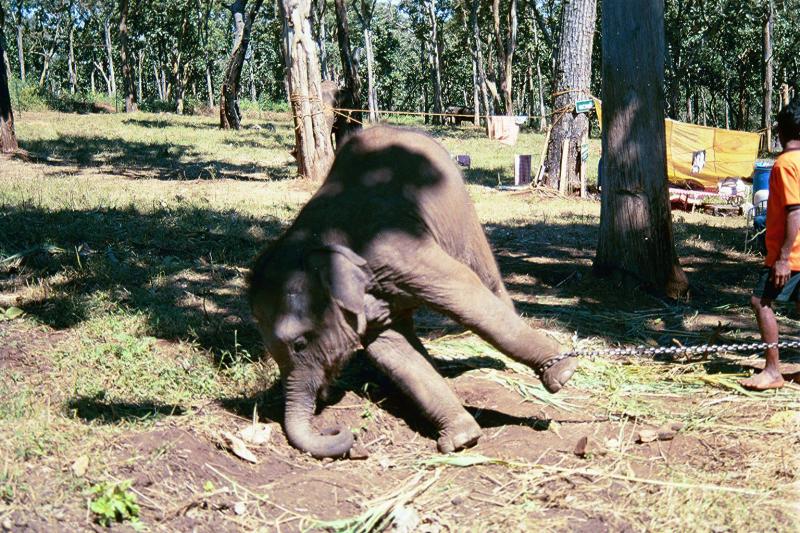
Photos : Dr. N Baskaran
In a first-of-its-kind study by researchers at the A.V.C. College, Mayiladuthurai, Tamil Nadu, and Dharmapuram Gnanambigai Government Arts College for Women, Mayiladuthurai, have explored the issue of stereotypy in captive Asian elephants in Tamil Nadu.
Gazing agape at the elephants in an enclosure at the zoo is a thrilling experience! The sight of these majestic animals making their way through a temple procession is a delight to the eyes and it is exhilarating to be able to get so close to these gentle giants! Elephants are undoubtedly a charismatic species and have a special place in our culture and in our hearts.
In the wild, elephants move across vast distances every day in search of food and other resources. They constantly interact with members of their herd, as well as with other species they come across. Their social life is one of the most complex among the animal species studied so far. But it all changes when they are kept captive, confined to small, barren enclosures, deprived of socialization and performance of other natural behaviours. These situations, scientists say, can lead to physiological and behavioural problems.
Captive animals have been known to show certain peculiar behaviours such as performing persistent, repetitive movements, which do not seem to have any obvious significance --walking up and down, shaking their heads, swaying, etc. This is called ‘stereotypic’ behaviour. Dr. Baskaran, an Asian elephant specialist and an assistant Professor at A.V.C. College, Mayiladuthurai, Tamil Nadu, has extensively studied this phenomenon.
“Stereotypic behaviour is an indication that the individual has been prevented from performing an instinctive act”, he says. Unlike mannerisms, stereotypy is abnormal and non-adaptive. Such behaviour is never seen in wild or free-ranging populations.
This study, from a country that has a natural population of elephants, investigates the prevalence, extent and causes of stereotypy. The researchers identify three different management systems—Hindu temples, private ownership facilities and the state forest department. Temples keep elephants for performing religious ceremonies, blessing devotees, for processions and other festivities. Privately owned elephants, on the other hand, are rented for events such as marriages, festivals, temple processions, film production and other commercial ventures. The forest department houses its elephants in timber camps, originally used for logging in the forest, but presently uses them for eco-tourism and patrolling purposes.
The authors conducted extensive surveys to observe the behaviour of elephants under these regimes. They observed stereotypic behaviours such as swaying of the body from side to side along with swinging of the trunk, also called ‘weaving’; repeated up and down or forward and backward rocking of the head, called ‘head bobbing’, and restless swinging of foreleg/hind leg while standing still, called ‘pacing’.
The study revealed that of the 144 captive elephants observed during 2003-2009, elephants kept in temples were the highest among those displaying stereotypic behaviour --49%. Also, 27% of elephants under private management and only 7% of elephants owned by the forest department displayed this behaviour. “Interestingly, the individuals showing stereotypic behaviour at the timber camps are the ones that have been transferred from zoos, returned from temples or confiscated from private ownership”, points out Dr. Baskaran.
The place where the elephants were managed had a clear influence on them, the study shows. Temples, which often kept elephants indoors for the longest durations, recorded the highest prevalence of stereotypies. Elephants belonging to the forest department showed the lowest prevalence of stereotypies, as they lived in conditions closest to their natural environment. What was disquieting was that 70% of housing facilities under private management and 59% under temple management did not meet the guidelines put forth by the Central Zoo Authority. In fact, none of the facilities had access to open outdoor enclosures. In addition, the study revealed that elephants displayed stereotypy either when being made to perform routine tasks, or during their long resting time when they are chained.
Another interesting finding from the study was the relationship between stereotypy and age of the elephant. Appearance of stereotypies decreased significantly with increase in age, indicating that younger individuals were most susceptible.
Dr. Baskaran sums up -- “It is clear that the management regimes at temples and private facilities are not conducive for the well-being of the elephants. Similarly, the zoo environment is especially unfavourable for juvenile and orphan elephants. Under natural conditions, juveniles typically spend a large proportion of their time engaging in play with their age-specific mates and in forming strong bonds especially with their maternal relatives.” He signs off with a word of advice to all those interested in holding elephants captive, “Early weaning and lack of free socialization with other elephants significantly impacts their health bringing about stereotypic behaviour”.





